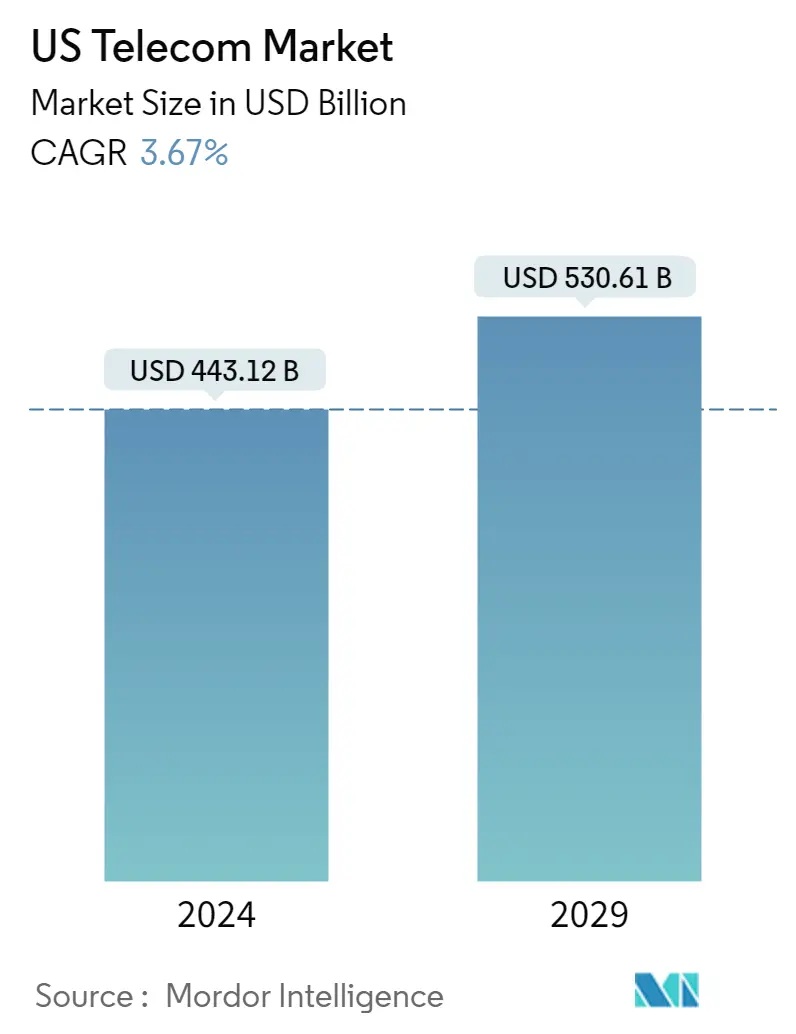Market Size of US Telecom Industry

| Study Period | 2019 - 2029 |
| Base Year For Estimation | 2023 |
| Market Size (2024) | USD 443.12 Billion |
| Market Size (2029) | USD 530.61 Billion |
| CAGR (2024 - 2029) | 3.67 % |
| Market Concentration | High |
Major Players
*Disclaimer: Major Players sorted in no particular order |
US Telecom Market Analysis
The US Telecom Market size is estimated at USD 443.12 billion in 2024, and is expected to reach USD 530.61 billion by 2029, growing at a CAGR of 3.67% during the forecast period (2024-2029).
Most of the major telecom companies in the world, such as AT&T, Verizon, and Comcast, are based in the United States, and they promote innovation by making significant R&D investments consistently. The United States telecommunication sector communications sector, which underpins the operations of all enterprises, public safety groups, and the government, is a crucial part of the country's economy.
- Even though the adoption of 5G technology is still in its infancy, AT&T, Verizon, T-Mobile, and US Cellular are already creating a roadmap for the deployment of next-generation 6G through strategic alliances. Moreover, the U.S. has the greatest levels of digitization in the world, which is driving up demand for services like OTT (over-the-top) media, messaging, and e-commerce and fostering future sector growth.
- To fulfill the ongoing demand for faster networks in 2021, the United States telecom industry made further strides in expanding its network capacity with further fiber and wireless deployments. The telecommunications infrastructure has relied on the big three traditional U.S. firms for over 20 years: AT&T, Verizon, and T-Mobile. Tech giants like Amazon, Facebook, Google, and Space X are gradually joining the space of these three. Most of the infrastructure used to transport people's data and content is already owned by the leading IT corporations.
- Utilizing a mix of open networks and the mobile virtual network operator (MVNO) business model, they have begun to provide internet access and mobile services. As per a GSMA report, in 2021, the country had a smartphone adoption rate of 83%, which is expected to rise to 85% in 2025. Subscriber penetration for FY 2021 was 85%. As per the study, the United States had a 4G penetration was 82% during 2021, compared with 15% and the rest of 3% for 3G and 2G. Concerning 5G adoption, the United States is one of the global leaders. The country is expected to have a 5G adoption of 68% by the end of 2025.
- For the US economy to revive and for the green and digital transformation to be realized, mobile networks are essential. Operators are becoming more aware of the potential spectral efficiency gains from deploying 4G and 5G in existing legacy technology bands as they seek to optimize their network operations and costs. As per a GSMA study, in February 2022, AT&T discontinued its 3G service, and by the end of the year, Verizon also plans to do the same. In June 2022, T-Mobile stopped supporting its 3G network, although it will continue to support its 2G network to serve IoT devices. Operators used a range of channels to tell customers about the suggested changes while also providing incentives (such as discounts on 4G and 5G devices and service plans) to speed up the migration. This helped to ensure a successful network switch-off.
- The COVID-19 pandemic had a significant impact on the US telecommunication industry and other facets of daily life across the country. A large portion of the United States population has been forced to spend almost constantly at home due to the pandemic, which has led to an increase in remote jobs, telemedicine, online education, and streaming in-home entertainment. The unexpectedly high demand for mobile and residential broadband access and capacity has so far been met by network providers. Due to shuttered storefronts and limited client mobility, service providers got the opportunity to improve their value proposition. However, the pandemic has also harmed the live effect on the pay-TV business and the cable TV industry. In the first quarter of 2020, the former lost over two million customers, which was mainly caused by the major cancellations of live shows and events.
US Telecom Industry Segmentation
The study provides an in-depth analysis of the telecommunication industry in the United States. The United States telecom market is segmented by service into voice services (wired, wireless), data and messaging services, and OTT and pay TV.
| Services (Coverage to Include Average Revenue Per User for the Overall Services Segment, Market Size and Estimates for Each Segment for 2020-2027 and In-depth Trend Analysis) | ||||
| ||||
| Data and Messaging Services (Coverage to Include Internet & Handset Data Packages, Package Discounts) | ||||
| OTT and Pay TV |
US Telecom Market Size Summary
The US telecom market is a pivotal component of the nation's economy, driven by major players like AT&T, Verizon, and Comcast, which are at the forefront of technological innovation through substantial R&D investments. The sector is experiencing a transformation with the gradual adoption of 5G technology, and companies are already strategizing for the next generation, 6G, through strategic partnerships. The high level of digitization in the US is fueling demand for services such as OTT media, messaging, and e-commerce, which are expected to drive future growth. The telecom infrastructure, traditionally dominated by AT&T, Verizon, and T-Mobile, is now seeing the entry of tech giants like Amazon, Facebook, Google, and SpaceX, who are leveraging open networks and MVNO models to offer internet and mobile services. The pandemic has accelerated the need for robust mobile and broadband solutions, as remote work, telemedicine, and online education became the norm, highlighting the sector's critical role in supporting the digital transformation of the economy.
The market is poised for growth, with 5G infrastructure expected to play a significant role in the next phase of the digital revolution, despite current challenges in consumer adoption. However, clear use cases in the business sector, such as industrial automation and remote workforce management, present opportunities for telecom companies to enhance profitability. The integration of cloud computing with telecom services is further reshaping the industry, enabling operators to offer scalable and flexible solutions. Companies like AT&T, Verizon, and T-Mobile are investing in advanced technologies to improve network capabilities and customer experiences. Strategic collaborations, such as those between Verizon and Amazon Web Services, are enhancing the value proposition of telecom services. The market's competitive landscape includes a mix of traditional telecom operators, ISPs, MVNOs, and emerging players, all vying for a share in the rapidly evolving digital economy.
US Telecom Market Size - Table of Contents
-
1. MARKET INSIGHTS
-
1.1 Market Overview
-
1.2 Industry Ecosystem Analysis
-
1.3 Industry Attractiveness-Porter's Five Force Analysis
-
1.3.1 Bargaining Power of Suppliers
-
1.3.2 Bargaining Power of Consumers
-
1.3.3 Threat of New Entrants
-
1.3.4 Threat of Substitute Products
-
1.3.5 Intensity of Competitive Rivalry
-
-
1.4 COVID-19 Impact on the Industry Ecosystem
-
1.5 Regulatory Landscape in the Country
-
-
2. MARKET SEGMENTATION
-
2.1 Services (Coverage to Include Average Revenue Per User for the Overall Services Segment, Market Size and Estimates for Each Segment for 2020-2027 and In-depth Trend Analysis)
-
2.1.1 Voice Services
-
2.1.1.1 Wired
-
2.1.1.2 Wireless
-
-
2.1.2 Data and Messaging Services (Coverage to Include Internet & Handset Data Packages, Package Discounts)
-
2.1.3 OTT and Pay TV
-
-
US Telecom Market Size FAQs
How big is the US Telecom Market?
The US Telecom Market size is expected to reach USD 443.12 billion in 2024 and grow at a CAGR of 3.67% to reach USD 530.61 billion by 2029.
What is the current US Telecom Market size?
In 2024, the US Telecom Market size is expected to reach USD 443.12 billion.

